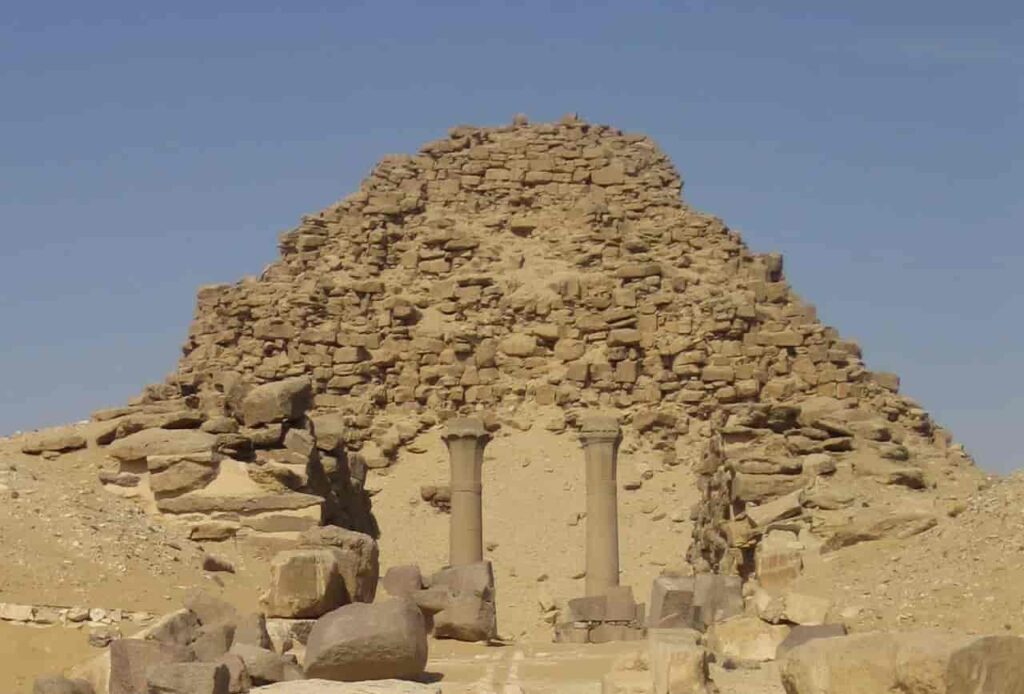Sahure (also Sahura, meaning “He who is close to Ra“) was a pharaoh of ancient Egypt and the second ruler of the Fifth Dynasty (c. 2465 – c. 2325 BC).

Sahure (also Sahura, meaning “He who is close to Ra“) was a pharaoh of ancient Egypt and the second ruler of the Fifth Dynasty (c. 2465 – c. 2325 BC).
He reigned for about 12 years in the early 25th century BC during the Old Kingdom Period. Sahure’s reign marks the political and cultural high point of the Fifth Dynasty.
He was probably the son of his predecessor Userkaf with Queen Neferhetepes II, and was in turn succeeded by his son Neferirkare Kakai.
During Sahure’s rule, Egypt had important trade relations with the Levantine coast. Sahure launched several naval expeditions to modern-day Lebanon to procure cedar trees, slaves and exotic items.
His reign may have witnessed the flourishing of the Egyptian navy, which included a high-seas fleet as well as specialized racing boats. Relying on this, Sahure ordered the earliest attested expedition to the land of Punt, which brought back large quantities of myrrh, malachite and electrum.
Sahure is shown celebrating the success of this venture in a relief from his mortuary temple which shows him tending a myrrh tree in the garden of his palace named “Sahure’s splendor soars up to heaven”. This relief is the only one in Egyptian art depicting a king gardening.
Sahure sent further expeditions to the turquoise and copper mines in Sinai. He also ordered military campaigns against Libyan chieftains in the Western Desert, bringing back livestock to Egypt.
Sahure had a pyramid built for himself in Abusir, thereby abandoning the royal necropolises of Saqqara and Giza, where his predecessors had built their monuments.
This decision was possibly motivated by the presence of the sun temple of Userkaf in Abusir, the first such temple of the Fifth Dynasty. The Pyramid of Sahure is much smaller than the pyramids of the preceding Fourth Dynasty but the decoration and architecture of his mortuary temple is more elaborate.
The valley temple, causeway and mortuary temple of his pyramid complex were once adorned by over 10,000 m2 (110,000 sq ft) of exquisite polychrome reliefs, representing the highest form reached by this art during the Old Kingdom period.
The Ancient Egyptians recognized this particular artistic achievement and tried to emulate the reliefs in the tombs of subsequent kings and queens. The architects of Sahure’s pyramid complex introduced the use of palmiform columns (that is columns whose capital has the form of palm leaves), which would soon become a hallmark of ancient Egyptian architecture.
The layout of his mortuary temple was also innovative and became the architectural standard for the remainder of the Old Kingdom period. Sahure is also known to have constructed a sun temple called “The Field of Ra”, and although it is yet to be located it is presumably also in Abusir.
Sahure was the object of a funerary cult, the food offerings for which were initially provided by agricultural estates set up during his reign. This official, state-sponsored cult endured until the end of the Old Kingdom. Subsequently, during the Middle Kingdom period, Sahure was venerated as a royal ancestor figure but his cult no longer had dedicated priests.

During the New Kingdom, Sahure was equated with a form of the goddess Sekhmet for unknown reasons. The cult of “Sekhmet of Sahure” had priests and attracted visitors from all over Egypt to Sahure’s temple. This unusual cult, which was celebrated well beyond Abusir, persisted up until the end of the Ptolemaic period nearly 2500 years after Sahure’s death.





